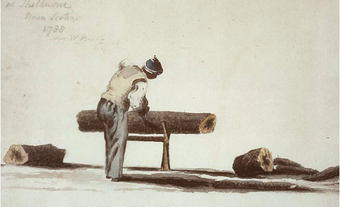"The mosquitoes," grumbled a suffering homesteader, "suck more Ukrainian blood than the landlords ever did in the old country." The speaker, one of the tens of thousands of Ukrainian peasants who immigrated to the prairies before the First World War, was not alone in this indictment of the new land. Merciless in the summer months, the stinging pests tortured settlers already coping with loneliness, unpredictable weather, and the challenge of clearing and breaking the land. Whether Canadian mosquitoes were actually worse than conditions in Europe that Ukrainians sought to escape, however, is debatable.
In the late 19th century Ukrainians lacked their own state. Instead, tsarist Russia ruled in the east, Austria-Hungary in the small western corner, where the provinces of Galicia and Bukovyna provided the bulk of Ukrainian immigrants to Canada. Frustrated in their ambitions and expectations in the aftermath of the abolition of serfdom in 1848, the immigrants left behind crippling debt, shrinking land holdings, and even the loss of their small plots that forced entire families to labour once again on the landlord's estate. The average peasant farm was 2.5 hectares, making Canada's promise of a quarter section of "free land" seem like paradise. Years later, one Ukrainian pioneer woman would remember her excitement as a young girl to learn she was coming to a country so rich that she imagined its borders to be braided with kovbasa, or garlic sausage, a rare treat at her parents' table.
The first two Ukrainians in Canada arrived in 1891. They were Ivan Pylypiw, a peasant entrepreneur from the village of Nebyliv in Galicia, and his one-time employee, Vasyl Eleniak. They came to check out the opportunities described in letters home by a German countryman who had settled east of Edmonton. This voyage, and the two men's enthusiasm, not only led to the arrival of the first permanent settlers a year later, but also determined the site of the first Ukrainian settlement in Canada at Edna-Star in east-central Alberta. Both Pylypiw and Eleniak would eventually join their compatriots there, and when they died their grave markers acknowledged their historic role as founding fathers.
In 1896 Clifford Sifton became Minister of the Interior in Sir Wilfrid Laurier's newly elected Liberal government. Sifton wanted to people the West with experienced farmers accustomed to hard work and a modest standard of living, and turned to previously untapped immigrant sources in central and eastern Europe. Despite Anglo-Canadian outcries against "foreigners," especially those from peasant cultures, Ukrainian immigration boomed. The newcomers preferred the treed parkland to the open prairie, in part because they believed that its soil was more fertile, and in part because after the abolition of serfdom they had to pay their former landlords for anything, including wood, gleaned from the forest. The newcomers wanted to be surrounded by their own kind, so the colony at Edna-Star mushroomed. At the same time, new settlement nuclei emerged, some started by Ukrainians themselves, others deliberately created by Ottawa as it tried to dilute the Ukrainian impact by spreading it over the entire region.
By 1914 a series of informal Ukrainian "blocs" of varying size crossed the three prairie provinces in a belt from southeastern Manitoba to just outside the Alberta capital. Within this area the immigrants recreated old-world kin and village networks, and maintained their traditional way of life, although the homesteading system precluded the replication of village structures themselves. The thatched, plastered, and white-washed cottages and onion-domed churches that stamped the landscape became its defining feature, and captivated the Anglo-Canadian teachers, missionaries, and travellers who worked in or passed through the blocs.
Today there are still mosquitoes as one drives through the old Edna-Star settlement. Occasionally, the decaying ruins of one-time pioneer dwellings ‒ their roofs collapsed, the plaster crumbling ‒ rise from brilliant yellow fields of canola. The farms themselves are prosperous, their gleaming silos competing with the domes of the photogenic pioneer churches that continue to dot the countryside and have joined the grain elevator as icons of a bygone era. Most Ukrainians no longer live on the land, and can be found in every walk of Canadian life. Yet the pioneer story remains important in the collective consciousness. To mark the one hundredth anniversary of their settlement in Canada in 1991, Ukrainians gathered at the site of the original Edna-Star colony. Governor General Ramon Hnatyshyn, himself a son of Ukrainian immigrants on the prairies, lit a commemorative flame (carried by torch relay from Edmonton, retracing the trek of the first settlers to their homesteads); those present then reaffirmed their oath of Canadian citizenship.
See also Ukrainian Cultural Heritage Village.

 Share on Facebook
Share on Facebook Share on X
Share on X Share by Email
Share by Email Share on Google Classroom
Share on Google Classroom





